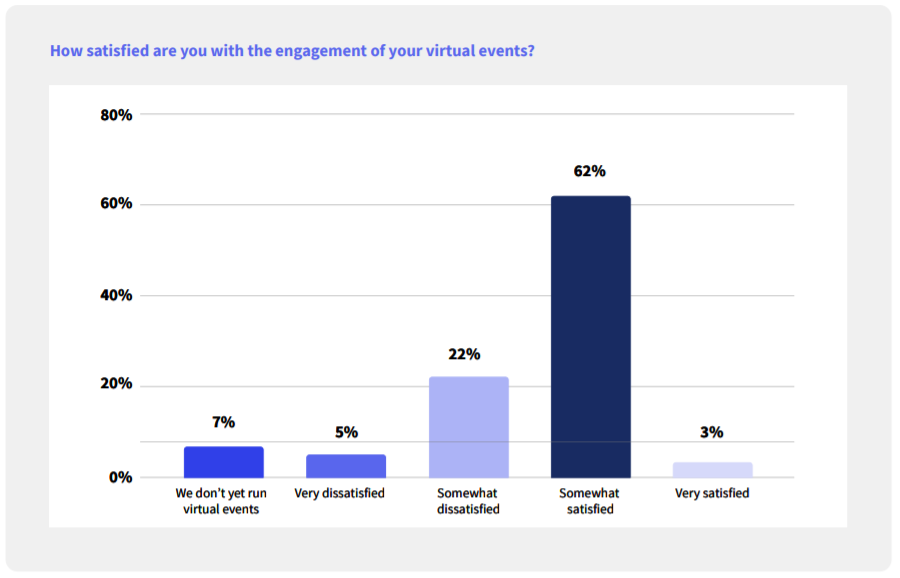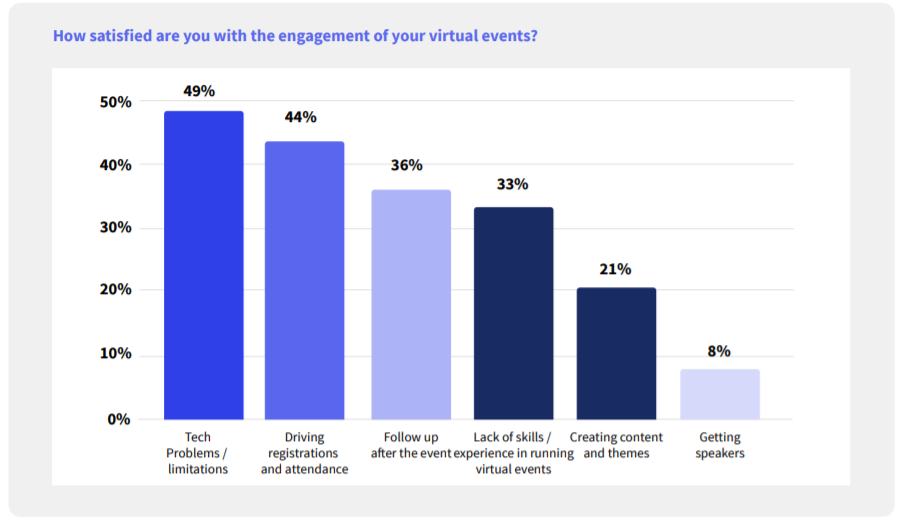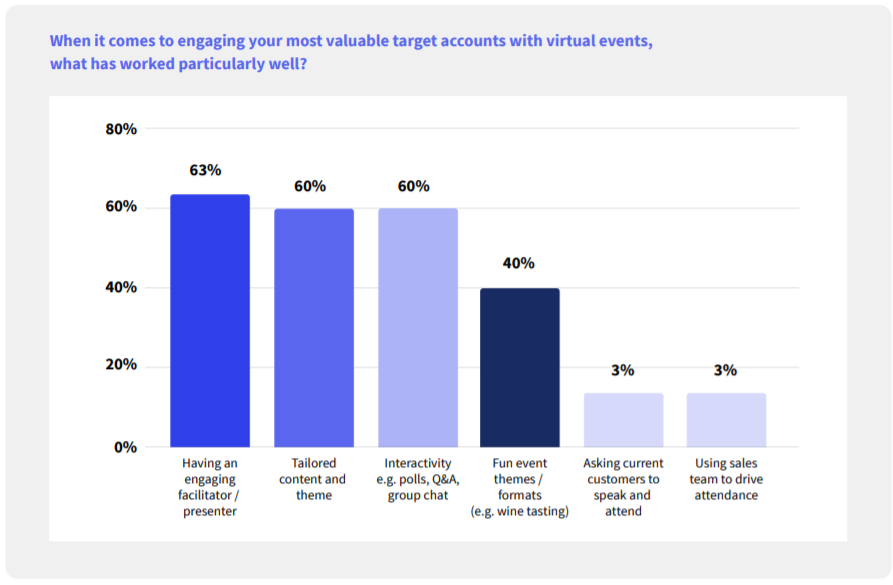Partner Content

Top Tips For Creating Authentic and Valuable Virtual Events
Executive Summary
B2B marketers have turned to virtual events like never before over the past months.
For many, the goal for these events has been to craft authentic, human and
memorable experiences that emulate what we remember from networking happy
hours or a tradeshow booth.
How do marketers move forward into a digital world where the most meaningful
aspects of face-to-face experiences must be translated into a virtual space? To answer
this question, ON24 sat down with marketing experts Craig McCartney, Managing
Director & Co-Owner at Chief Nation, and Virginie Maillet, High-Touch Marketing
Manager at Citrix. This report summarizes their thoughts and the input shared by the
audience.
Here are a few highlights from the discussion:
Virtual events can and do work well
Any question about whether virtual experiences can really work well can be answered
with a resounding yes. The majority of respondents to an ON24 poll were somewhat
(65%) or very (3%) satisfied with the engagement of their virtual events.
In our experts’ opinions, an increase in virtual experiences leads to meaningful
engagement, but only if events are approached in the right way – that is, not as
a copy-and-paste replacement for face-to-face events, but carefully thought-out
translations of them.
Target and scale your engagement
Our experts have created digital experiences for both targeted ABM-style approaches
and large-scale programs.
Virginie and Craig have seen virtual experiences step in for some of their core bespoke
face-to-face strategies over the past year, taking the form of wine tastings, breakfast
networking events, breakout spaces and digital boardrooms.
And, applicable to experiences overall, Tessa offers her four Ts of great virtual
experiences: Time, Team, Turnout and Technology.
Find the human element for authentic experiences
Among respondents to an ON24 poll, engagement and authenticity are key to
driving success with virtual experiences – including an engaging presenter (63%),
tailored content and themes (60%) and interactivity (60%).
Our experts emphasise using all the tools at your disposal to bring human connection
into virtual spaces, such as breakout rooms, chatrooms, Q&As and polls. Creating an
environment where attendees feel secure in exchanging knowledge is important, as
well as maintaining a sense of fun.
It’s important to note that creating an awesome experience does not mean compromising on your business goals. Connection and conversion can be balanced
to make virtual experiences a win-win.
How to learn more
The webinar generating these insights is always-on and ready to view.
Register now to hear more.
To sign up to future sessions, visit www.on24.com/resources/upcoming-webinars
Tessa Barron, VP Marketing at ON24, would like to thank Craig McCartney, Managing
Director & Co-Owner at Chief Nation, and Virginie Maillet, High-Touch Marketing
Manager at Citrix, for joining the discussion and providing valuable recommendations
for today’s B2B professionals.
How well can virtual events really work?
Over the past 12 months, many marketers have turned to virtual events to make up for a lack of in-person meetings. As such, marketers can be forgiven for wondering if virtual events can replace the face-to-face strategies they have relied on for so long.
In a recent ON24 poll of B2B marketers, the answer appears to be a resounding yes.

Some two-thirds of marketers responding to our poll said they are somewhat (62%) or very (3%) satisfied with the engagement of their virtual events. Roughly a fifth of (22%) say they are somewhat dissatisfied, and only 5% are very dissatisfied.
For dissatisfied marketers, or for those in a similar place to the 7% of respondents who don’t yet run virtual events, let’s take a look at what our experts think about how well these events can really work.
Rethink and manage your expectations
First, don’t fixate on the differences between physical and virtual events. Instead, accept those differences and adapt your approach to the event based on that reality. For Tessa,
virtual events are about translating, not dragging-and dropping, physical events. In her words:
“Set expectations for the context in which you are delivering this new experience. Those connections that happened at a networking happy hour or an ad-hoc swing by at a trade show booth where you found that lead that was ready to buy, are going to be more difficult to do in the digital world.”
This is not to say that running virtual events means accepting compromise – in fact, the opposite is true.
For Virginie and Citrix, virtual events have opened doors for the company in terms of allowing for targeted engagement on an intimate scale. But Virginie reminds marketers that experiences need to be thoughtfully crafted – understanding how you can harness the unique benefits of a virtual approach is key to that thought process.
Craig agrees but looks at this from the alternate perspective of how the digital world can connect your company to a much wider audience, overcoming barriers of travel,
accommodation and family commitments. He recounts his experience of this success:
“We ran over 100 virtual events last year, and some of the feedback we got from guests was that this is nearly, if not even better than, the live thing.”
By the numbers, virtual events bring unique value to marketing strategies. As Tessa recounts, at ON24 virtual events are engaging around 100,000 attendees for an
average of 60-75 minutes quarterly. Compared to the advertising dollars required to drum up an equivalent number of website visits, often for much less time, virtual
events are a pot of gold when it comes to the potential scale of engagement.
Remember the fire ant
When in doubt, remember the fire ant. Craig draws on nature’s example when talking about how Chief Nation navigated the difficulties of the past year. He talks about how Amazonian fire ants survive flood season by linking together to form living rafts, rather than accepting defeat.
The COVID-19 pandemic was a major flood season for B2B marketers whose
businesses are built on in-person events. But Craig encourages marketers to think of the fire ant as inspiration to come together and create a unique and strong virtual offering in the face of adversity.
What do great virtual experiences look like?
So, how can you create fun, interactive digital experiences that audiences love and are happy to engage with?
First, it’s important to recognize some of the hurdles that come with creating virtual experiences.
B2B marketers shared their own challenges in an ON24 poll:

Respondents reported being most challenged by tech problems or limitations (49%) and driving registrations and attendance (44%). They also feel challenged by follow-up after the event (36%), lack of skills/experience in running virtual events (33%), and creating content and themes (21%).
How did our experts overcome these challenges to produce successful virtual experiences?
Create digital networking and bespoke experiences
Craig and Chief Nation learned the best approach when their key VIP experience, Chief Wine Officer, had to be translated into a digital offering. Their first step was recognizing that
the event — which combined peer-to-peer networking and education with wine tasting — could not be simply replicated, but its most valuable characteristics could be carried over:
“One of the tricks was trying to translate the networking elements, and having your camera on is a great way to do that. You look to create some business content, some group discussion, a little bit of entertainment, some education, and a little bit of competition for good measure.”
Chief Nation now runs an array of events focusing on linking the digital with the human, including breakfast networking cafes and smaller micro-networking experiences via CEO digital boardrooms. Craig notes that each of these events is supported by a strong theme that ensures attendees find them truly valuable.
How Citrix has changed its events
Citrix made the decision early on in 2020 to commit to no in-person events for the year, a decision continuing into the first half of 2021. So, like many companies, its tactics in approaching events had to change significantly.
As Virginie has seen, virtual experiences can be hugely successful when applied to ABM programs and targeted events. But Citrix learned lessons about facilitating large virtual events during its recent EMEA Work Summit, with 3,000 registrants.

One lesson was the importance of crafting relevant content for different personas. This made it so attendees could easily navigate an experience and drive great outcomes. Another lesson was being imaginative with format, and understanding that presentations might not always be what attendees want – videos, podcasts and gamification are all great ways to change up an experience.
To replicate the look and feel of a physical summit, the event also made use of virtual booths. In an EMEA context, these can help to localize content offerings if attendees have different language requirements.
The four Ts
ON24 has worked with thousands of customers in the past year, and learned something about virtual experiences from each one. To summarise these learnings in a memorable way, Tessa offers the Four Ts:
1. Time
When it comes to virtual events, start at the end. Compared to a physical event where content is created in real time, a virtual event provides the benefit of being able to plan in advance how you are going to follow up after the experience. You and your team can, and should, take advantage of this more flexible time. Tessa says:
“You can do things in parallel. If you have two weeks to put on an event, you can start
promoting as you’re producing. You don’t have to scurry around and find a space first – you’ve got one.”
2. Team
Everything starts with people. In the world of physical events, marketers were typically siloed by channel, but in the digital world marketing teams need to come together to put the buyer at the center of an integrated, seamless experience. Think of the event journey as a funnel through
which your prospect needs to be nurtured – this means integrating and aligning your team.
3. Turnout
In many cases, virtual experiences will be widening your reach from the hundreds to the thousands. While this a huge positive, you have to be prepared for the impact this will have on your funnel. If faced with an inundation of leads, make sure you have a process in place to identify the leads in an audience who are ready to talk to sales.
4. Technology
Technology can be a deciding factor in the success of your virtual experience. Yes, your event has to look great on the front end – which itself comes with technical priorities – but that’s not the endpoint. In Tessa’s words:
“A virtual event needs to deliver the insights that you need on the backend to ensure
that you’re delivering your sales team an opportunity to continue the conversation, versus starting a new one. It needs to capture that data and those intent signals.”
How can marketers bring authentic and engaging virtual events to life?
So, you’ve got your attendees through the digital door. How do you take your virtual experiences to the point where they stand out from the pack and keep people coming back for more?

According to ON24 poll respondents, the top tactic to engage valuable target accounts through virtual events was to have an engaging facilitator or presenter (63%). Respondents also reported success with tailored content and themes (60%), interactivity like polls, Q&A and group chats (60%) as well as fun event themes/formats (40%).
Find the human in digital events
All of these successful virtual event approaches share a common theme: Facilitating genuine human connection.
In Craig’s experience with smaller-scale bespoke events, a virtual experience should facilitate a one-to-one conversation. If this isn’t literally possible, it should mimic the connection and human element of such a conversation. Automation and paid channels are great for achieving at scale, but smaller events that aim to recreate networking opportunities or a high-touch experience need to make attendees feel more special. Craig says:
“You want to try and facilitate new business relationships and connections, and you need
to make it genuine.”
Some key characteristics of an authentic experience that facilitates this connection include powerful business themes; virtual breakout spaces in which attendees can share knowledge and build up a rapport; sufficient preparation time; a compelling agenda; and the right attendees.
Make your events worth attending and engaging with
For Virginie, the most authentic and standout virtual events facilitate an exchange of value. Attendees want to be in a secure environment to exchange knowledge, receive peerto-peer feedback and share their challenges.
Citrix has found that implementing the Chatham House Rule — where participants are free to use information gleaned from a meeting, but not free to identify the speaker — during certain events has instilled a level of trust that aids human connection between attendees. ON24’s own poll and Q&A feature is a great example, facilitating the sharing of knowledge in a way that allows attendees to remain anonymous.
It’s also important to remember that your own team is a key player in that exchange of value. As such, Tessa acknowledges the cynical marketer who might be asking: What’s in it for us? She says:
“A trap that some marketers fall into is focusing so much on the connection that you forget about the conversion. And it’s really important to have both.”
Networking is a great example of holding that balance. In a virtual space, setting up specific chat or breakout rooms for attendees to talk about their achievements gives them the benefit of kudos, and your team the benefit of facilitating the kind of authentic engagement that used to only happen at physical events like happy hours.
Tessa also cites great companion content such as workbooks or deliverables as a sure route to generating the human connection that makes an attendee want to follow up with your sales team.
Explore hybrid models
As we move into 2021, B2B marketers are starting to think about what the future holds for their events and experiences. While many businesses took further steps into the digital world out of necessity last year, this is not to say that the events and experiences landscape will return to its
pre-pandemic state. After all, if virtual events open up an alternative route to authentic engagement, why would we turn back?
Virginie predicts that Citrix will rely on a hybrid model, after experiencing the doors opened by the virtual space in terms of lifting travel and geography limitations. She also concurs with Tessa that great virtual events require collaboration between teams, and that this has been a great exercise for Citrix in heightening the experience provided for their customers.
Tessa also notes certification as an example of an engaging offering to customers that is often improved by taking place in a virtual experience. Certifications can be automated, are more inclusive, and attendees can immediately share their achievements.
However, Craig offers a reminder that entering into this hybrid space will require careful cost-benefit analysis to make sure that your team stays on top of the type of experiences that are valuable to your prospects as well as your company.
Final takeaways
Here are our experts’ top tips to take away on the topic of creating human engagement:




